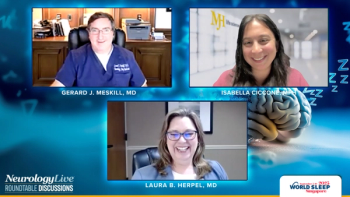
Treatment Barriers: Cost, Location, and Delivery
Episodes in this series

Philippa Cheetham, MBChB, MRCS, MD, FRCS: Dr Proud, do you ever have the situation where you’ve got a patient you know is going to respond, who is the perfect candidate, but you are hit with a brick wall trying to get coverage? Some of these drugs are extremely expensive. Do you find that depending on a patient's insurance that you may not be able to get the drug as quickly as you want, or there's a lot of hurdles in getting coverage to start the medication as soon as possible?
Crystal Proud, MD: You mentioned before some of the ways that we assess whether somebody is responding to treatment. And that actually is dictated by insurance. We're utilizing scales that were really created for research purposes, and now we've had to bring them into the clinic because of insurance mandates. And so we will do testing. I'm sure you love these clinic days where we put you through hours of testing.
Sebastian Mills: Yes.
Crystal Proud, MD: My physical therapist and occupational therapist in clinic will perform things like the revised upper limb module, which looks at upper limb strength, and it gives a standard score. Something called the Hammersmith Functional Motor Scale Expanded, the HFMSE. We do that as well, which looks at all sorts of muscle strength—leg muscles, arm muscles, hip girdle muscles—and gives you once again a collective score. Those are 2 that are applicable to somebody who is Sebastian's age. And then, we have different scores for our children, our babies with things called the HINE [Hammersmith Infant Neurological Examination] and the CHOP INTEND [Children’s Hospital of Philadelphia Infant Test of Neuromuscular Disorders]. And so we do that at baseline pretreatment, and then every 6 months. And we are mandated to do that to authorize and reauthorize these medications.
Philippa Cheetham, MBChB, MRCS, MD, FRCS: Sure. Sebastian, you mentioned that you were in college when you first heard about this. Did that mean that you had to travel a long way to get treatment with Dr Proud, going to a center of excellence? Was it a real inconvenience to start off getting treatment?
Sebastian Mills: Actually, no. I went to Hampton University, which is still within the area of Virginia, so I didn't have to go as far. But I know that Dr Proud said if I ever traveled outside of Virginia or moved, that there would be a way that I could still come back and still get the medication that I needed.
Philippa Cheetham, MBChB, MRCS, MD, FRCS: The initial medications; we've heard that there are a number of treatment options on the horizon, and some are already being used regularly in clinical practice. There are obviously oral medications, and then we hear about therapies that are going directly into the spinal cord. Can you elaborate a little bit on the medications that Sebastian got and the form, the mode of delivery that those treatments took?
Sebastian Mills: The first FDA approved treatment is nusinersen, or Spinraza, and that is a medication that acts on that backup gene that we were talking about. And what it does is it works on that SMN2 gene to improve production of the survival motor neuron protein. That's what Sebastian receives. It is the only one that is FDA approved for patients of his age. And it is an intrathecal infusion. And so, that means I deliver it through a spinal tap. And it's done in 2 phases, so the loading dose phase with administration on the first day of treatment, followed by another treatment 2 weeks later, then 2 weeks after that, 30 days later, and then every 4 months.
Philippa Cheetham, MBChB, MRCS, MD, FRCS: Dr Proud is talking about this injection that you got into your spine.
Sebastian Mills: Yes.
Philippa Cheetham, MBChB, MRCS, MD, FRCS: Quite a scary thing to go through.
Sebastian Mills: Yes.
Philippa Cheetham, MBChB, MRCS, MD, FRCS: Had you had spinal taps before receiving this medication?
Sebastian Mills: No, not at all.
Philippa Cheetham, MBChB, MRCS, MD, FRCS: When she first told you about receiving a medicine that was going directly into your spine, what did you think about that?
Sebastian Mills: I thought, “I don't know about that one,” but I said, “Well, we're already here. Let's go ahead and try,” but I was a little freaked. I have a bunch of tattoos, but something going into the spine was a little scary.
Philippa Cheetham, MBChB, MRCS, MD, FRCS: You had that done in the office, did you?
Sebastian Mills: Yes, she gives an option that she does a numbing creams, and then you can put ice on it. I'm starting to realize I like the ice a lot better because it does numb the area a lot more. And then from there, I’m kind of in a fetal position, and she goes ahead and gives me my infusion from there.
Philippa Cheetham, MBChB, MRCS, MD, FRCS: How soon after getting the infusion did you start to notice some improvement in your symptoms?
Sebastian Mills: People may not believe me, but the first time I got it, my legs were feeling warm. So I'm like okay, I think it's working.
Crystal Proud, MD: Your parents called me the next day. They said he's outside washing the car.
Sebastian Mills: I would say within the next couple of months, I did start to see a difference. I wasn't falling as much. Previously before getting my medication, I used to fall a lot. My leg or my knee would give out a lot. Now, I have a lot more strength. I'm able to do a lot more than I was able to do, as well as being able to drive. That was a big concern for my parents, losing that motor skill. I'm still able to drive. I still have some things that I'm working toward, but my strength is a lot better, to where it’s maintaining, so I don't end up hurting myself.
Philippa Cheetham, MBChB, MRCS, MD, FRCS: How many injections have you received into the spine?
Sebastian Mills: She's going to have to answer that.
Crystal Proud, MD: You’ve been on treatment since April 2018, so, many.
Philippa Cheetham, MBChB, MRCS, MD, FRCS: What's the time frame between each infusion?
Crystal Proud, MD: Now he goes every 4 months in the maintenance phase.
Philippa Cheetham, MBChB, MRCS, MD, FRCS: And the dose for maintenance is a lower dose than the original doses?
Crystal Proud, MD: No, it's actually all the same, which is interesting. And it's all the same no matter whether you're an adult or a baby.
Newsletter
Keep your finger on the pulse of neurology—subscribe to NeurologyLive for expert interviews, new data, and breakthrough treatment updates.



















































